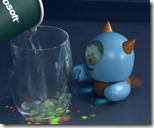Surface Monster Mashup and real-world objects
When we talk about what we’re doing here at Microsoft Surface, there are several attributes that come to mind. Sometimes for those who haven’t been exposed to a lot of touch and multi-touch, it seems like all touch is the same. Here’s a crash course to bring you up to speed.
 Two Important Attributes
Two Important Attributes
One aspect to keep in mind when thinking about Surface is the massive multi-touch that is provided by the hardware. This is very important for multiple users, or together computing. When you have several people clustered around a device, the experience breaks down if you can only handle a few touches. Many multi-touch monitors only handle two touches. That may be okay for a single user scenario on a desktop or laptop PC, but Surface enables so much more collaboration, allowing over 50 touches at once. Another important aspect is objects. The vision system in Surface can see what’s going on the table-top. This allows for all manner of natural user interfaces to be employed both with everyday objects, and objects specifically crafted to work with Surface. These objects both make Surface more engaging and it can be more efficient at the same time.
Monster Mashup and Objects @ PDC
Today at PDC, Robert Levy and Anson Tsao talked about Microsoft Surface and Windows 7 for .NET developers. (We’ll recap in another post once the session video comes out.) During that discussion, Robert showed some video that really speaks to the amazing things you can do with Surface and objects. High resolution tags that are unique into the billions really expand the possibilities beyond simple tags. Attendees of PDC have seen this in the contact cards they’re using to digitally connect with each other on Surface.
As promised, here are the videos shown in the session that illustrate these points. Enjoy!